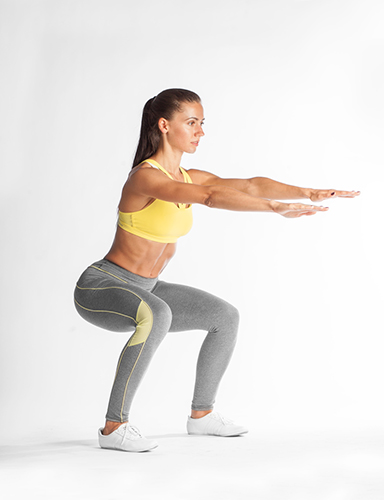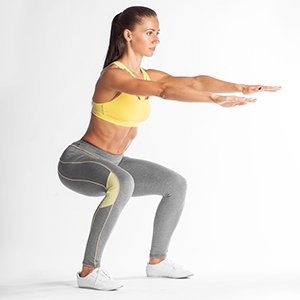
The ability to perform a squat is essential in today’s society. It is used in order to pick up something from the floor, get into and out of a chair or bed, and is required in most sporting events. If an individual does a squat incorrectly, this places increased stress on the hips, knees, and ankles which will eventually lead to an injury. In order to perform a squat using the correct technique, it requires a good combination of mobility and strength.
Based on research, a normal squat requires adequate motion of the hips, knees, and ankles. The hips need roughly 42 degrees of motion. If a patient has tightness in the hamstrings or glutes, this motion may not be obtained. Stretching these structures for 3 times for 30 seconds, 5 days a week for a few weeks will decrease tightness. For the knee, approximately 70 degrees of motion is required. If there is tightness in the hamstrings or quads, this motion will not be reached. Stretching using the same principles above will increase motion and allow full range required for a squat. Finally, the ankle joint requires 28 degrees of motion. The calf muscle is the most limiting factor if an individual lacks ankle mobility. It is important to stretch both the gastrocnemius and soleus in order to obtain full mobility. Performing a calf stretch with the knee straight will stretch the gastrocnemius and performing it with the knee bent will stretch the soleus.
For the strength component of a squat, a large amount of muscles are involved. The two most important muscles are the quadriceps and glutes. These muscles have to be able to lower the body slowly when going down and be able to push you when you want to go back up. The body sees this as two different muscle actions and an individual has to be able to perform both in order to have a successful squat. If there are weak glutes, bridges are a great exercise to increase strength and control of this muscle. 3 sets of 10 reps is a good starting point if these muscles are weak. If the quadriceps are weak, straight leg raises are a great exercise. Using the same principles as the one for bridges is sufficient in building strength in these muscles. New research has shown the value of the strength of the VMO (Vastus Medialis Oblique), which is part of the quadriceps. Research states that when doing a squat, it fires the most of the four quadriceps muscles. When doing a straight leg raise, if doing it with the right foot, turning the foot to 2 o’clock, and if doing it with the left, turning the foot to 10 o’clock will help isolate this muscle more. Weakness in the muscle has been shown to lead to patellofemoral pain syndrome and other common knee pathologies and can occur in any population.
A squat is performed many times in our daily lives, but if performed improperly, can lead to increased stress on the joints and eventually lead to an injury. If you are feeling pain in any part of your legs, seeking a physical therapist can help identify and eliminate your pain, as well as help you regain your function. If you have any questions, our therapy staff at Sterling Ridge Orthopedics is here to assist you.






